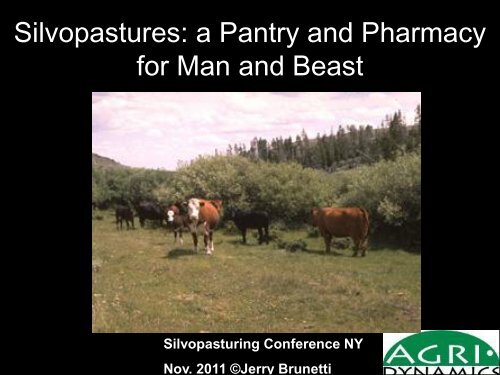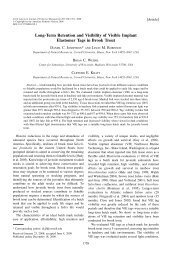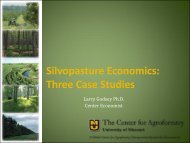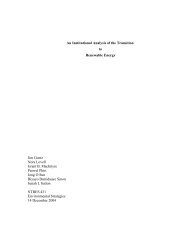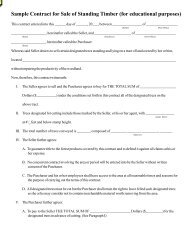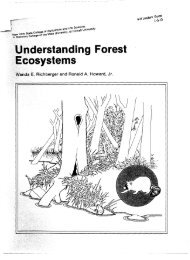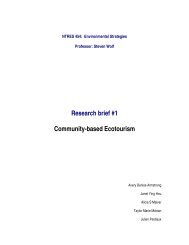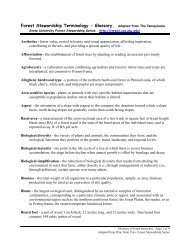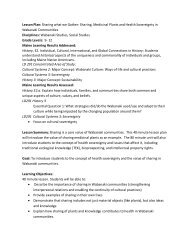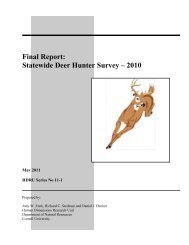Silvopastures: a Pantry and Pharmacy for Man and Beast
Silvopastures: a Pantry and Pharmacy for Man and Beast
Silvopastures: a Pantry and Pharmacy for Man and Beast
You also want an ePaper? Increase the reach of your titles
YUMPU automatically turns print PDFs into web optimized ePapers that Google loves.
Nov. 2011 ©Jerry Brunetti<br />
<strong>Silvopastures</strong>: a <strong>Pantry</strong> <strong>and</strong> <strong>Pharmacy</strong><br />
<strong>for</strong> <strong>Man</strong> <strong>and</strong> <strong>Beast</strong><br />
Silvopasturing Conference NY
Phytochemistry of Plant Constituents<br />
• Amino Acids<br />
• Carbohydrates<br />
• Lipids<br />
• Polyphenols<br />
• Terpenes<br />
• Sterols<br />
• Alkaloids<br />
Over 80,000<br />
Isolated Plant Compounds
Plant Primary Compounds<br />
• Energy: Sugars, Cellulose, Hemi-cellulose, Fats<br />
(PUFA’s, Mono, EFA’s, Saturated), Starch, Fructans,<br />
Glucans, etc.<br />
• Protein: 50,000 Different Kinds (22 Amino Acids)<br />
• Minerals: Macro (Ca, Na, Cl, P, K, Mg, S); Micro (B,<br />
Cr, Se, I, Mn, Fe, Co, Zn, Cu, Mo, Vn, Si)<br />
• Vitamins: (A, D, E & K), B-Complex <strong>and</strong> Ascorbate
Plant Secondary Metabolites<br />
•Terpenes: (Carotenoids, Essential Oils) 25,000<br />
- Protect Chlorophyll from U.V.<br />
- Pest Resistance<br />
•Phenolics: (e.g. Tannins, Lignin) 8,000<br />
-Builds Organic Matter<br />
-Protection from Environmental Extremes including Flavonoids<br />
•Alkaloids: 8,000<br />
-Pest Resistance<br />
-Germination Rates,<br />
-Drought Tolerance
Plant Secondary Metabolites as Defense<br />
• Grazing Animals (tannins,<br />
essential oils, alkaloids)<br />
• Ultra Violet Radiation<br />
• Bacteria, Fungi, Virus<br />
• Defense Against Competing<br />
Plants (walnuts)<br />
• Vulnerable Fruits & Younger<br />
Tissue are higher in PSM’s
Plant Secondary Metabolites as Attractants<br />
Color to Attract<br />
Pollinators<br />
Perfume to Attract<br />
Pollinators<br />
Molecular Signals to<br />
Promote Colonization<br />
by Mycorrhizae <strong>and</strong><br />
Rhizobia
Pollinators<br />
• Hundreds of Thous<strong>and</strong>s!<br />
– Bats, mosquitoes, mice, ants, opossums, bees, monkeys,<br />
beetles, flies, lizards, birds, butterflies, flying foxes<br />
–
Anti-Pest Exudates<br />
Root Volatiles<br />
• Attract enemies of root feeding pests<br />
Eg: Sesquiterpene B-caryophyllene<br />
attracts nematode<br />
(Hetero rhabditis megadis)<br />
attacks beetle larvae<br />
(diabrotica virgifera)<br />
Atmospheric Volatiles<br />
• Atmospheric volatiles warn neighbors gene expression<br />
• Produce repellents, intoxicants against enemies<br />
• Attract seed dispersers <strong>and</strong> pollinators
UNIVERSTIY OF NEW HAMPSHIRE<br />
FORESTRY RESEARCH
Maple Leaf<br />
Poplar Leaf<br />
Rapid Changes in Tree Leaf Chemistry Induced<br />
by Damage: Evidence <strong>for</strong> Communication<br />
Between Plants<br />
Ian Baldwin; Jack Schultz: Science, July 15, 1983, Vol. 221 pp<br />
277-279
Elephant Feeding on Mopane Trees (Colophospermum mopane)
Giraffes Feeding on<br />
Acacias
Herbivores Consume Bulk as 3-7 Plants/Meal<br />
Herbivores “Nibble” on 50-100 Plants per Day
Resource Rich Environments<br />
• Organic Matter,<br />
Nutrients, Water,<br />
Sunlight<br />
• Promote Plants with<br />
High Levels of<br />
Primary<br />
Compounds <strong>and</strong><br />
Moderate Levels of<br />
Secondary<br />
Compounds<br />
• Positively Influence<br />
the Flavor, Color,<br />
Quality, of Meat &<br />
Milk
Resource Poor Environments<br />
(Naturally Occurring)<br />
• Lower Levels<br />
of Primary<br />
Compounds<br />
• High Levels<br />
of Secondary<br />
Compounds<br />
– Deter<br />
Feeding by<br />
Herbivores
Resource Poor Environments<br />
(<strong>Man</strong>-Made)<br />
• Lower Levels of some/all<br />
Primary Compounds<br />
• Low Levels of Secondary<br />
Compounds<br />
• Negative Influence of<br />
Flavor, Color, Quality of<br />
Meat & Milk
•Attract Highly Specialized Herbivores<br />
•Herbivores Attract Generalist Predators<br />
• Predators Feed on Pests<br />
•Hedgerows Create More Bio-Mass (a.k.a Dry Matter) For<br />
Every Level of Livestock (microbial to ruminant)
British Hedgerows<br />
2,000 years of Biodiversity<br />
• 600 plant species<br />
• 1500 insect species<br />
• 65 bird species<br />
• 20 mammal species<br />
Micro-Climate: Transpiration by Day Dew at night<br />
Position Hedgerows on Higher Ground<br />
-fertility moves down hill<br />
Australian Hedgerows: 50-100 meters wide
The Original Permaculturalist
Average Composition of Nuts & Other Foods<br />
KIND OF<br />
FOOD<br />
REFUSE<br />
%<br />
WATER<br />
%<br />
PROTEIN<br />
% FAT %<br />
CARBOHYDRATES<br />
SUGARS,<br />
STARCH,<br />
ETC. %<br />
CRUDE<br />
FIBER % ASH %<br />
FUEL<br />
VALUE/ #<br />
Calories<br />
Acorn, fresh 17.80 34.7 4.4 4.7 50.4 4.2 1.6 1265<br />
Almond 47.00 4.9 21.4 54.4 13.8 3.0 2.5 2895<br />
Beechnut 69.90 6.6 21.8 49.9 18.0 3.7 2740<br />
Brazil Nut 49.35 4.7 17.4 65.0 5.7 3.9 3.3 3120<br />
Butternut 86.40 4.5 27.9 61.2 3.4 3.0 3370<br />
Chestnut,<br />
fresh 15.70 43.4 6.4 6.0 41.3 1.5 1.4 1140<br />
Chestnut, dry 23.40 6.1 10.7 7.8 70.1 2.9 2.4 1840<br />
Chestnut<br />
Flour …… 7.8 4.6 3.4 80.5 3.4 1780<br />
Filbert 52.08 5.4 16.5 64.0 11.7 2.4 3100<br />
Hazelnut Meal …… 2.7 11.7 65.6 17.8 2.2 3185<br />
Hickory Nut 62.20 3.7 15.4 67.4 11.4 2.1 3345<br />
Other foods<br />
<strong>for</strong><br />
Comparison<br />
……<br />
Beans Dried …… 12.6 22.5 1.8 55.2 4.4 3.5 1650<br />
Potatoes 20.00 78.3 2.2 0.1 18.0 0.4 1.0 385<br />
Apples 25.00 84.6 0.4 0.5 13.0 1.2 0.3 290
Copper Content in mg/kg Dry Matter in Leaves & Grass<br />
Sycamore Maple<br />
7.7<br />
(Nitrogen accumulator)<br />
Field Maple 11.2<br />
Birch 12.2<br />
Oak 12.0<br />
Alder (Nitrogen accumulator) 13.6<br />
Elder 12.0<br />
Ash 18.2<br />
Smooth Oat Grass 3.6<br />
Cocksfoot 6.7<br />
Crushed Barley 2.7
Gemmotherapy<br />
• Detoxification<br />
• Drainage
Biological Activity of Bee Propolis in Health & Disease<br />
Asian Pacific Journal of Cancer Prevention<br />
Volume 7, 2006, 22-31<br />
• Anti-Bacterial<br />
• Anti-Viral<br />
• Anti-Fungal<br />
• Anti-Inflammatory<br />
• Anti-Parasitical<br />
• Anti-Tumor<br />
• Anti-Ulcer<br />
• Liver Protective<br />
• Brain Protective<br />
• Heart Protective<br />
• Immuno-Stimulant<br />
More than 300 compounds!<br />
Dependent Upon Geography <strong>and</strong> Time of Year
Osage Orange<br />
Persimmon<br />
Kentucky Coffee Tree<br />
Filbert<br />
Common Paw Paw
Choke Cherry<br />
S<strong>and</strong> Cherry<br />
Nanking Cherry<br />
Buffalo Berry
Plum<br />
Apricot<br />
Apple<br />
Pear
Cornelius<br />
Dogwood<br />
Currants<br />
Viburnum<br />
Elderberry
Persimmon<br />
Grapes<br />
Raspberries<br />
Thornless<br />
Blackberries
Riparian Buffers
Silvo Pasturing
Oak Savannah
Environmental Stress Factors<br />
1. Average Minimum Air Temp. (Wind Chill?)<br />
2. Average Maximum Air Temp.<br />
3. Radiant Heat Load (Infra-red?)<br />
4. Hours Above 89°F/29.5°C (Humidity?)
Temperature Thresholds<br />
• At 72°F Milk Production Begins to Drop Slowly<br />
• At 80°F Milk Production Begins to Drop Suddenly<br />
Holsteins & Jerseys will seek shade at 84°F/27°C<br />
• Each Hot (>85°F/27°C) <strong>and</strong> Muggy (humidity>45%)<br />
Day Reduced Summer Long Steer Gains By 1 lb.<br />
(0.45 Kg)<br />
(Southern Plains Exp. Range, Woodward, OK)
Hydraulic Lift & Redistribution<br />
“Hydraulic Lift: Consequences of Water Efflux from the Roots of Plants”<br />
Martin Caldwell, Todd Dawson, James Richards
Hydraulic Lift & Redistribution<br />
9-18 Gallons per<br />
tree, per Night<br />
Water Harvested @<br />
6’(+) below & “Banked”<br />
<strong>for</strong> Following Day<br />
“Hydraulic Lift: Consequences of Water Efflux from the Roots of Plants”<br />
Martin Caldwell, Todd Dawson, James Richards
Flax Row
Flax Gel
Poplar Row
Poplar Sprout
Fuijoa Row
Fuijoa Flowering
ALFALFA D<strong>and</strong>elion Lamb's Qtr Chicory Comfrey Plantain Leaf Burdock Cleavers Dock<br />
Protein 20.97% 25.00% 31.70% 19.5 23.7 19.6 25.7 29.0 11.7 32.7<br />
Digestable Protein 14.7 18.5 14.7 20.4 23.5 7.3 26.9<br />
Soluble Protein 4.7 2.7 2.9 4.3 3.9 1.2 1.6<br />
Protein Solubility 50.07% 24.40% 18.10% 24.2 11.4 15.0 16.8 13.4 9.9 4.9<br />
Nitrogen/Sulfur Ratio 11:1 10:1 12:1 8:1 14:1 6:1 4:1 5:1 7:1 15:1<br />
Acid Detergent Fiber 32.10% 19.20% 15.00% 32.8 29.8 34.1 22.6 25.1 40.6 19.5<br />
Neutral Detergent Fiber 43.61% 30.00% 21.90% 46.8 42.2 45.8 34.4 36.5 49.1 44.7<br />
Relative Feed Value 136.20% 229.00% 329.00% 126 145 127 193 177 108 153<br />
TDN (est.) Total Digestible Nutients 63.89% 80.90% 85.60% 63.5 66.8 64.4 74.5 71.8 57.1 77.8<br />
ME (mcal/lb) 1.33 1.41 1.04 1.10 1.06 1.22 1.18 0.94 1.28<br />
Est. Net Energy (therms/cwt) 69.9 74.3 54.0 57.0 54.7 64 61.6 48 67.1<br />
NE/Lact (mcal/lb) 0.65 0.85 0.9 0.65 0.69 0.66 0.77 0.75 0.58 0.81<br />
NE/Maint (mcal/lb) 0.895 0.959 0.648 0.697 0.661 0.806 0.768 0.551 0.853<br />
NE/Gain (mcal/lb) 0.6 0.655 0.383 0.426 0.394 0.523 0.490 0.295 0.564<br />
Calcium 1.58% 1.04% 1.10% 0.89 2.73 1.84 4.38 2.10 1.3 0.83<br />
Phosphorous 0.37% 0.33% 0.39% 0.31 0.20 0.26 0.41 0.34 0.39 0.37<br />
Potassium 2.05% 4.46% 7.66% 3.59 3.94 2.97 3.01 3.28 2.46 3.53<br />
Magnesium 0.46% 0.26% 0.55% 0.26 0.39 0.17 0.39 0.43 0.25 0.64<br />
Sodium 759ppm 0.04 0.04 0.011 0.005 0.028 0.014 0.020<br />
Sulfur - total 0.31% 0.41% 0.43% 0.37 0.27 0.53 0.94 0.90 0.26 0.35<br />
ppm Iron 171 657 91 195 176 83 349 149 70 111<br />
ppm Copper 15 15 8 14 29 12 11 26 13 13<br />
ppm Zinc 30 34 46 43 46 44 40 32 127 38<br />
ppm <strong>Man</strong>ganese 23 35 138 36 192 30 36 47 66 36<br />
ppm Boron 50 30 44 28 42 29 67 32 15 31<br />
Nettle<br />
Curly
Day Lily Day Lily Echinacea Wild Grape Wild Rasp Willow Hazlenut Mulberry Chinese<br />
ALFALFA Leaf Blossom Leaf Leaf Leaf Leaf Leaf Leaf Chstnt Lf<br />
Protein 20.97% 20.6 23.4 15.7 22.1 15.2 19.8 14.1 26.2 21.8<br />
Digestable Protein 15.7 18.3 11.1 17.1 10.6 14.9 9.6 20.9 16.7<br />
Soluble Protein 5.4 14.8 1.8 1.2 0.4 1.5 0.7 3.6 14.7<br />
Protein Solubility 50.07% 26.4 63.0 11.4 5.6 2.8 7.5 4.9 13.7 67.7<br />
Nitrogen/Sulfur Ratio 11:1 19:1 20:1 12:1 14:1 16:1 7:1 14:1 17:1 11:1<br />
Acid Detergent Fiber 32.10% 28.2 17.0 20 19.5 22.6 24.9 20.2 21.5 41.2<br />
Neutral Detergent Fiber 43.01% 35.7 23.5 29.3 34.6 43.1 37.6 42.3 34.2 70.9<br />
Relative Feed Value 136.20% 175 299 233 198 154 172 161 197 75<br />
TDN (est.) 63.89% 70.9 83.4 77.3 77.8 74.5 72 77.1 75.7 54.6<br />
ME (mcal/lb) 1.16 1.37 1.27 1.28 1.22 1.18 1.27 1.24 0.9<br />
Est. Net Energy (therms/cwt) 60.7 72.2 66.6 67.1 64 61.8 66.4 65.1 45.7<br />
NE/Lact (mcal/lb) 0.65 0.74 0.87 0.81 0.81 0.77 0.75 0.8 0.79 0.55<br />
NE/Maint (mcal/lb) 0.756 0.929 0.845 0.853 0.806 0.771 0.842 0.823 0.513<br />
NE Gain (mcal/lb) 0.479 0.629 0.557 0.564 0.523 0.493 0.555 0.538 0.259<br />
Calcium 1.58% 0.81 0.39 2.57 1.91 0.85 1.45 1.44 3.09 1.37<br />
Phosphorous 0.37% 0.25 0.43 0.25 0.32 0.16 0.23 0.12 0.26 0.2<br />
Potassium 2.05% 2.24 2.17 2.22 0.95 1.6 1.71 0.75 1.85 0.84<br />
Magnesium 0.46% 0.20 0.17 0.88 0.25 0.29 0.27 0.31 0.34 0.37<br />
Sodium 759ppm 0.025 0.05 0.02 0.02 0.01 0.011 0.04 0.016 0.015<br />
Sulfur - total 0.31% 0.17 0.19 0.21 0.25 0.15 0.44 0.16 0.24 0.31<br />
ppm Iron 171 203 86 131 502 100 117 118 154 120<br />
ppm Copper 15 10 22 21 16 18 13 19 12 15<br />
ppm Zinc 30 25 66 32 32 35 105 27 36 61<br />
ppm <strong>Man</strong>ganese 23 54 40 132 89 210 101 373 63 160<br />
ppm Boron 50 49 16 66 31 23 34 28 36 72
•<br />
•<br />
•<br />
•
Mulberry<br />
ALFALFA Leaf<br />
Protein 20.97% 26.2<br />
Digestable Protein 20.9<br />
Soluble Protein 3.6<br />
Protein Solubility 50.07% 13.7<br />
Nitrogen/Sulfur Ratio 11:1 17:1<br />
Acid Detergent Fiber 32.10% 21.5<br />
Neutral Detergent Fiber 43.01% 34.2<br />
Relative Feed Value 136.20% 197<br />
TDN (est.) 63.89% 75.7<br />
ME (mcal/lb) 1.24<br />
Est. Net Energy (therms/cwt) 65.1<br />
NE/Lact (mcal/lb) 0.65 0.79<br />
NE/Maint (mcal/lb) 0.823<br />
NE Gain (mcal/lb) 0.538<br />
Calcium 1.58% 3.09<br />
Phosphorous 0.37% 0.26<br />
Potassium 2.05% 1.85<br />
Magnesium 0.46% 0.34<br />
Sodium 759ppm 0.016<br />
Sulfur - total 0.31% 0.24<br />
ppm Iron 171 154<br />
ppm Copper 15 12<br />
ppm Zinc 30 36<br />
ppm <strong>Man</strong>ganese 23 63<br />
ppm Boron 50 36
Persimmons<br />
•Great companion fruit to Mulberry<br />
-Drops fruit from August- January<br />
•Grows in all soils<br />
•Fruit = 35% solids (apple = 13%)<br />
•Fruit = 32% sugars (apple = 10%)<br />
•Fruit rich in proteolytic enzymes (papain, bromelain),<br />
potassium, calcium, phosphorus, vitamin C, betacarotene
•<br />
•
Honey Locust Pasture<br />
(Gladitsia triacanthos)<br />
Alabama Ag Experiment Station<br />
Auburn, Alabama 1942-1945<br />
• 48 trees per acre @ 60 lbs pods/tree =<br />
3,000 lbs pods/acre<br />
– Equivalent to 50 bu. Corn or 100 bu. Oats<br />
– Pod sugar content @ 29-39% (sugar beets)<br />
– Protein at 13%<br />
• 2.5 tons of hay/acre as understory crop
•<br />
•<br />
•
ALFALFA Burdock<br />
Protein 20.97% 29.0<br />
Digestable Protein 23.5<br />
Soluble Protein 3.9<br />
Protein Solubility 50.07% 13.4<br />
Nitrogen/Sulfur Ratio 11:1 5:1<br />
Acid Detergent Fiber 32.10% 25.1<br />
Neutral Detergent Fiber 43.61% 36.5<br />
Relative Feed Value 136.20% 177<br />
TDN (est.) Total Digestible Nutients 63.89% 71.8<br />
ME (mcal/lb) 1.18<br />
Est. Net Energy (therms/cwt) 61.6<br />
NE/Lact (mcal/lb) 0.65 0.75<br />
NE/Maint (mcal/lb) 0.768<br />
NE/Gain (mcal/lb) 0.490<br />
Calcium 1.58% 2.10<br />
Phosphorous 0.37% 0.34<br />
Potassium 2.05% 3.28<br />
Magnesium 0.46% 0.43<br />
Sodium 759ppm 0.028<br />
Sulfur - total 0.31% 0.90<br />
ppm Iron 171 149<br />
ppm Copper 15 26<br />
ppm Zinc 30 32<br />
ppm <strong>Man</strong>ganese 23 47<br />
ppm Boron 50 32<br />
Alfalfa<br />
Versus<br />
Burdock
•Tonifying Properties<br />
•Diuretic<br />
•Expectorant<br />
•Restorative<br />
Properties <strong>for</strong> the<br />
Liver,<br />
<strong>and</strong><br />
Kidneys
Nettle<br />
ALFALFA Leaf<br />
Protein 20.97% 25.7<br />
Digestable Protein 20.4<br />
Soluble Protein 4.3<br />
Protein Solubility 50.07% 16.8<br />
Nitrogen/Sulfur Ratio 11:1 4:1<br />
Acid Detergent Fiber 32.10% 22.6<br />
Neutral Detergent Fiber 43.61% 34.4<br />
Relative Feed Value 136.20% 193<br />
TDN (est.) Total Digestible Nutients 63.89% 74.5<br />
ME (mcal/lb) 1.22<br />
Est. Net Energy (therms/cwt) 64<br />
NE/Lact (mcal/lb) 0.65 0.77<br />
NE/Maint (mcal/lb) 0.806<br />
NE/Gain (mcal/lb) 0.523<br />
Calcium 1.58% 4.38<br />
Phosphorous 0.37% 0.41<br />
Potassium 2.05% 3.01<br />
Magnesium 0.46% 0.39<br />
Sodium 759ppm 0.005<br />
Sulfur - total 0.31% 0.94<br />
ppm Iron 171 349<br />
ppm Copper 15 11<br />
ppm Zinc 30 40<br />
ppm <strong>Man</strong>ganese 23 36<br />
ppm Boron 50 67
•Cleanses the Blood<br />
•Excellent Diuretic<br />
•Tonifying<br />
Properties<br />
•Enhances Hepatic<br />
Function
ALFALFA D<strong>and</strong>elion<br />
Protein 20.97% 25.00%<br />
Digestable Protein<br />
Soluble Protein<br />
Protein Solubility 50.07% 24.40%<br />
Nitrogen/Sulfur Ratio 11:1 10:1<br />
Acid Detergent Fiber 32.10% 19.20%<br />
Neutral Detergent Fiber 43.61% 30.00%<br />
Relative Feed Value 136.20% 229.00%<br />
TDN (est.) Total Digestible Nutients 63.89% 80.90%<br />
ME (mcal/lb) 1.33<br />
Est. Net Energy (therms/cwt) 69.9<br />
NE/Lact (mcal/lb) 0.65 0.85<br />
NE/Maint (mcal/lb) 0.895<br />
NE/Gain (mcal/lb) 0.6<br />
Calcium 1.58% 1.04%<br />
Phosphorous 0.37% 0.33%<br />
Potassium 2.05% 4.46%<br />
Magnesium 0.46% 0.26%<br />
Sodium 759ppm<br />
Sulfur - total 0.31% 0.41%<br />
ppm Iron 171 657<br />
ppm Copper 15 15<br />
ppm Zinc 30 34<br />
ppm <strong>Man</strong>ganese 23 35<br />
ppm Boron 50 30
•<br />
•<br />
•<br />
•<br />
•<br />
•
Willow<br />
ALFALFA Leaf<br />
Protein 20.97% 19.8<br />
Digestable Protein 14.9<br />
Soluble Protein 1.5<br />
Protein Solubility 50.07% 7.5<br />
Nitrogen/Sulfur Ratio 11:1 7:1<br />
Acid Detergent Fiber 32.10% 24.9<br />
Neutral Detergent Fiber 43.01% 37.6<br />
Relative Feed Value 136.20% 172<br />
TDN (est.) 63.89% 72<br />
ME (mcal/lb) 1.18<br />
Est. Net Energy (therms/cwt) 61.8<br />
NE/Lact (mcal/lb) 0.65 0.75<br />
NE/Maint (mcal/lb) 0.771<br />
NE Gain (mcal/lb) 0.493<br />
Calcium 1.58% 1.45<br />
Phosphorous 0.37% 0.23<br />
Potassium 2.05% 1.71<br />
Magnesium 0.46% 0.27<br />
Sodium 759ppm 0.011<br />
Sulfur - total 0.31% 0.44<br />
ppm Iron 171 117<br />
ppm Copper 15 13<br />
ppm Zinc 30 105<br />
ppm <strong>Man</strong>ganese 23 101<br />
ppm Boron 50 34
Kiwi Willow Analysis<br />
Dry Basis As Recd Dry Basis As Recd<br />
% MOISTURE 21.7<br />
% DRY MATTER 78.3<br />
% PROTEIN 20.8 16.3<br />
% AVAILABLE PROTEIN 20.8 16.3<br />
% DIGESTIBLE PROTEIN 15.8 12.4<br />
% ACID DETERGENT<br />
FIBER 32.9 25.7<br />
% NEUTRAL DET. FIBER 40.4 31.7<br />
RFV 146<br />
%TDN 63.5 49.8<br />
ME (MCAL/LB) 1.043 0.817<br />
EST. NET ENERGY<br />
(T/CWT) 53.9 42.3<br />
NE/LACT (MCAL/LB) 0.653 0.512<br />
NE/MAINT (MCAL/LB) 0.648 0.508<br />
NE/GAIN (MCAL/LB) 0.383 0.300<br />
%NDFD 48 Hr, % NDF 39.2 30.7<br />
% CALCIUM 1.42 1.11<br />
% PHOSPHORUS 0.41 0.32<br />
% POTASSIUM 1.53 1.20<br />
% MAGNESIUM 0.16 0.13<br />
IRON PPM 151 119<br />
COPPER PPM 11 9<br />
ZINC PPM 49 38<br />
MANGANESE PPM 29 23<br />
% FAT 3.1 2.5<br />
% ASH 7.4 5.8<br />
% SUGAR 10.8 8.4<br />
RFQ 142<br />
% TDN- Univ. Wis. UW 62.3 48.8<br />
NE/LACT (MCAL/LB) UW 0.639 0.501<br />
MILK LBS./TON OF DM 2,839<br />
% IVTD 74.2 58.2<br />
NSCa 28.2 22.1<br />
4,500 Cuttings/Ha 1,800 Cuttings/ Acre 43,000 SF/AC ÷ 1800 = (1) per 25 square feet<br />
1.5 meter pollard height 6 tons edible dry matter/acre
Mean faecal egg counts (FEC) as eggs/g of faeces <strong>for</strong><br />
undrenched lambs on the three <strong>for</strong>age treatments.<br />
One of three rotations in Browse block<br />
2400 trees/acre
Liveweight gain (LWG; g/day) <strong>and</strong> final dag score (units).
Salix humboltiana<br />
Salix matsudana<br />
Salix tangoio<br />
Salix kinayanagi<br />
www.hortresearch.co.nz/index/page/549<br />
www.hortresearch.co.nz/projects/fodder<br />
www.hortresearch.co.nz/wprc<br />
“Tree Grower” “Growing Today”<br />
“The Dominion Post” (Jan. & Feb. 2007)
Tannins (Phenolics)<br />
• Makes By-Pass Protein<br />
– EAA & BCAA Reproductive Efficiency<br />
– Reduces Rumen Ammonia (less BUN/MUN)<br />
– Enhances Immunity<br />
• Resistance Against Internal Parasites<br />
• Alleviates Bloat (binds to proteins in rumen)<br />
• Reduces Methane Production<br />
• Meat is lighter in color<br />
• Meat is higher in anti-oxidants<br />
• Meat is higher in Omega 3<br />
• Meat is lower in “gamey” flavor
Coping with Tannins<br />
• Large increase by Parotid Gl<strong>and</strong>s (Salivary) in Monogastrics of<br />
Proline-Rich Proteins (PRP) (Bind Tannins)<br />
– Binds tannins provided there’s enough energy<br />
(carbohydrate) to keep polypeptide chain adhesive to<br />
tannins<br />
– Humans can consume high tannin sorghum <strong>and</strong> red wine<br />
• Endocrine adaptation occurs in ruminants<br />
– Glycerol released from adipose tissue
Biodiverse Feedback Loop Systems<br />
• Tall Fescue: Endophyte<br />
(Alkaloid-Nitrogen Steroid)<br />
• Birdsfoot Trefoil: Condensed<br />
Tannins<br />
Binds nitrogen in Rumen<br />
Alfalfa: Saponins<br />
Binds Steroids in GI Tract<br />
Okunda, T. et. al. “Effects of Interaction of Tannins <strong>and</strong> Coexisting<br />
Substances; Formation <strong>and</strong> Solubilization of Precipitates with<br />
Alkaloids.” J. Pharm. Soc. Japan 102:854-858
Sheep on Rangel<strong>and</strong><br />
• Prefer<br />
Sagebrush in<br />
Morning<br />
• Prefer Mixed<br />
Shrubs <strong>and</strong><br />
Crested<br />
Wheatgrass<br />
Mid-Day<br />
• Prefer Salt<br />
Brush in<br />
Evening<br />
Gade & Provenza “Nutrition of sheep grazing crested<br />
wheatgrass versus wheat grass shrub pastures during<br />
winter.” J. Range <strong>Man</strong>agement 39:527-530
Alkaloids<br />
(Major Deterrent of Grazing)<br />
Betalain Alkaloids (Red/Purple)<br />
•Pokeberry (Phytolacca)<br />
•Beets<br />
Indole Alkaloids<br />
• Bitter in Taste (The Bitters)<br />
• Antidote to Excessive Tannin<br />
Intake<br />
• Synthesized in Roots<br />
• Common Alkaloids<br />
-Nicotine (Insecticide)<br />
-Caffeine (Slug-o-cide)<br />
-Morphine<br />
-Cocaine<br />
•Yohimbe<br />
•Cinchona: Quinone
Plant Defense & Animal Response<br />
Tropical Pastures<br />
Stylosanthes spp. Legume<br />
– a-pinene <strong>and</strong> sticky resin<br />
• Cattle tick immobilized by resin, killed by a-pinene<br />
“Insects <strong>and</strong> Plant Surface” by Sutherst, R.W. <strong>and</strong> Wilson, L.J. (1986) pp. 185-194
Terpenes<br />
• Monoterpenes<br />
– Anti-microbial<br />
– Anti-cancer<br />
• Essential Oils<br />
– Peppermint<br />
– Thyme<br />
– Oregano<br />
– Citrus<br />
• Small Volatile Molecules
Carotenes<br />
(Terpenes)<br />
•Alpha, beta, delta, gamma<br />
•Orange/yellow pigments<br />
•Dark green plants
Lycopene du Jour
Autumn Olive<br />
•17x Lycopene of<br />
Tomatoes<br />
•Nitrogen Fixing<br />
•Leaves are Fodder<br />
•Chelates Lead & Zinc<br />
•Nectar <strong>for</strong> Pollinators<br />
•Wildlife Food & Habitat
Who’s a Native- Who’s a Foreigner???<br />
“It is unlikely that empirical studies, if undertaken, could show that<br />
in r<strong>and</strong>omly selected ecosystems, non-native species, especially<br />
plants, are more important factors in extinction than are native<br />
species <strong>and</strong> many other contributing causes <strong>and</strong> conditions.”<br />
Mark Sagoff, PhD Senior Research Scholar<br />
Institute <strong>for</strong> Philosophy <strong>and</strong> Public Policy at the University of Maryl<strong>and</strong><br />
“The overall pattern almost always is that there’s some net<br />
increase in diversity, that seems to be because these native<br />
communities of species don’t completely fill all the niches. The<br />
exotics can fit in there.”<br />
Dr. James Brown, Ecologist at the University of New Mexico in “Friendly<br />
Invaders”
Who’s the Invasive Species???
Ben Mead’s Cows<br />
Eating Japanese<br />
Knotweed<br />
Ben Mead’s Cows<br />
Eating Nettle
Xanthophylls<br />
(Oxygenated Carotenes)<br />
•Lutein (kale, collards, spinach, egg yolk)<br />
•Capsanthin (peppers)<br />
•Cryptoxanthin<br />
•Zeaxanthin
Organic Milk’s Grass Pigments<br />
(Danish Institute of Agricultural Research)<br />
• 50% More Vitamin E<br />
• 75% More Beta Carotene<br />
• 200-300% More Lutein & Zeaxanthine
The Benefits of Carotenoids<br />
• Pro-Vitamin A (beta carotene): Animals cannot synthesize Vitamin A<br />
– Normal Development of skin, mucosa<br />
– Vision, Reproduction, resistance to bacterial/fungal disease<br />
• Endocrine Function<br />
– Gonadal Development/Maturation<br />
– Fertilization, Hatching, Growth<br />
• Protein Stability & Enzyme Function<br />
• Cell Membrane Permeability<br />
• Olfactory & Chemoreception<br />
• Oxygen Reservoirs (Oxygenation of Cells)<br />
• Mitochondria: Cross membrane calcium transfer<br />
• Anti-Oxidant: Absorb/reflect U.V. radiation <strong>and</strong> quench singlet oxygen<br />
• Immune Enhancement<br />
– N.K. Cell activity<br />
– Generate Wound/Healing<br />
– Slow Down Tumor Growth<br />
• Appetite Stimulation
“Antibiotic Properties of Essential Oils”<br />
International Journal of Food Microbiology 5 (1987) 165-180<br />
Plant Essential Oils Tested <strong>for</strong> Antibacterial Properties<br />
Almond (bitter) Caraway Fennel Melissa Rosemary<br />
Almond (sweet) Cardamom Geranium Mint (apple) Sage<br />
Angelica Celery Ginger Nutmeg St Johns Wort<br />
Anise Cinnamon Laurel Orange Sassafras<br />
Basil Citronella Lavender Orange (bitter) Spike<br />
Bay Clove Lemon Parsley Star Anise<br />
Bergamot Cori<strong>and</strong>er Lime Pepper Thuja<br />
Calamus Dill Lovage Peppermint Thyme<br />
Chamomile Estragon M<strong>and</strong>arin Pimento Valerian<br />
Cananga Eucalyptus Marjoram Rose Verbena
Test Bacteria (25)<br />
Acinetobacter calcoacetica Aeromonas hydrophila Alcaligenes faecalis<br />
Bacillus subtilis<br />
Baneckea natriegens<br />
Brevibacterium linens<br />
Brocothrix thermospacta Citrobacter freundi Clostridium sporogenes<br />
Enterobacter aerogenes Erwinia carotovora Escherichia coli<br />
Flavobacterium suaveolens Klebsiella pneumoniae Lactobacillus plantarum<br />
Leuconostoc cremoris Micrococcus luteus Moraxella sp<br />
Proteus vulgaris Pseudomonas aeruginosa Salmonella pullorum<br />
Serratia marcescens Staphylococcus aureus Streptococcus faecalis<br />
Yersinia entercolitica
Test Results<br />
• All 50 Plant E.O’s inhibited at least (1)<br />
bacterium<br />
• 41 plant E.O.’s inhibited (5) or more<br />
bacterium<br />
• 33 plant E.O.’s inhibited (10) or more<br />
bacterium<br />
• 10 plant E.O.’s inhibited (20) or more<br />
bacterium
Essential Oil<br />
Number of genera<br />
Angelica 25<br />
Bay 24<br />
Cinnamon 23<br />
Clove 23<br />
Thyme 23<br />
Almond (bitter) 23<br />
Marjoram 22<br />
Pimento 22<br />
Geranium 21<br />
Lovage 20
Effect of Various Essential Oils Isolated from<br />
Douglas Fir Needles upon Sheep & Deer<br />
Rumen Microbial Activity<br />
Applied Microbiology, July 1967, p. 777-784
A<br />
Effect of<br />
Essential<br />
Oils From<br />
Douglas Fir<br />
Needles<br />
TIME (HOURS)
A<br />
Effect of<br />
Essential<br />
Oils From<br />
Douglas Fir<br />
Needles<br />
Time Hours
Newman Turner<br />
“Weed” Preferences to Supplement<br />
Grasses & Legumes<br />
Chicory<br />
Burnet<br />
Sheep’s Parsley<br />
Kidney Vetch<br />
Plantain<br />
D<strong>and</strong>elion<br />
Fennel<br />
2 lbs<br />
4 lbs<br />
2 lbs<br />
1 lb<br />
1 lb<br />
1 lb<br />
½ lb
Foraging Behavior:<br />
<strong>Man</strong>aging to Survive<br />
in a World of Change<br />
By Frederick D. Provenza
Farm as Farmacy<br />
“We have seen the future<br />
of medicine <strong>and</strong> the future<br />
is food.”<br />
Dr. Mitch Gaynor<br />
New York Strang Center<br />
<strong>for</strong> Cancer Prevention


